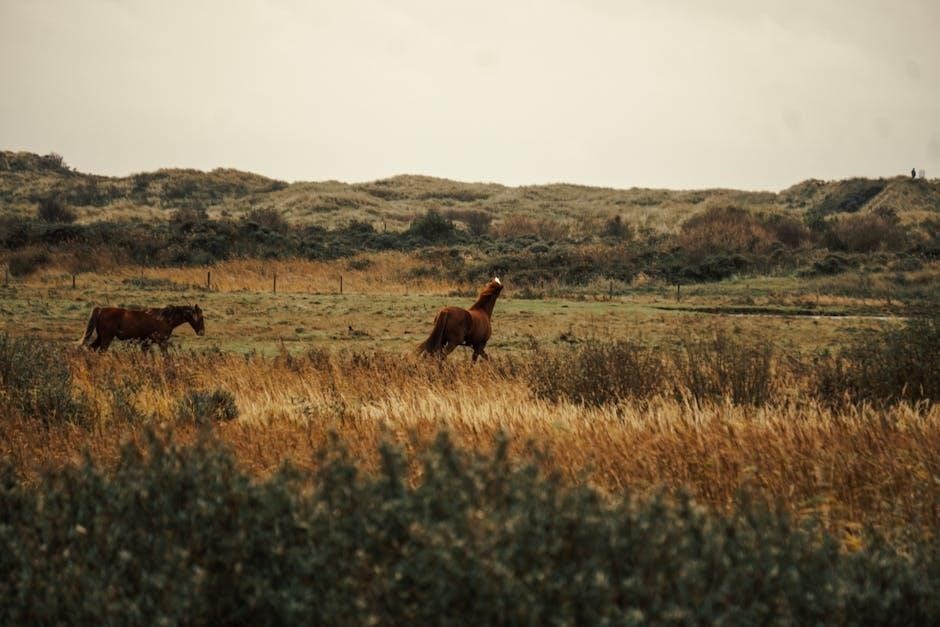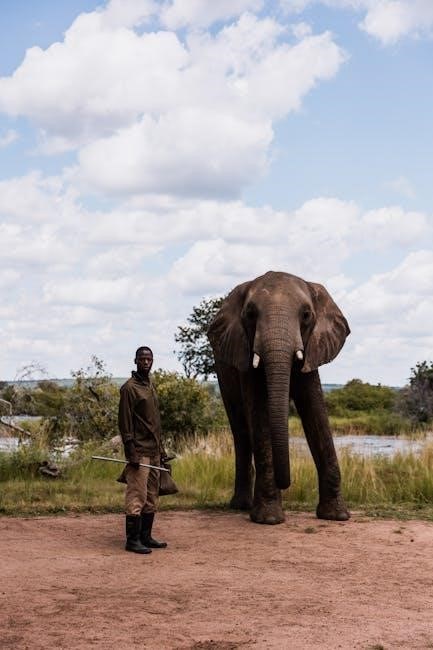A field guide is a versatile resource used to identify and understand various species, landscapes, or phenomena. It combines detailed descriptions, visuals, and expert knowledge to enhance exploration and learning.
What is a Field Guide?
A field guide is a resource designed to help identify, understand, and explore species, objects, or phenomena in their natural environment. It typically includes detailed descriptions, high-quality photos, illustrations, and expert tips. Field guides can be specific to regions, habitats, or taxonomic groups, making them invaluable for naturalists, students, and enthusiasts. They come in various formats, from pocket-sized books to digital apps, offering practical knowledge for accurate identification and fostering a deeper connection with nature.
Importance of Field Guides in Natural Sciences
Field guides are essential tools in natural sciences, aiding in species identification, education, and research. They provide detailed descriptions, visuals, and expert knowledge, enabling accurate recognition of plants, animals, and other phenomena. By fostering a deeper understanding of ecosystems, field guides support conservation efforts and promote public awareness of biodiversity. They are invaluable for students, researchers, and enthusiasts, bridging the gap between scientific knowledge and practical application in the field.

Types of Field Guides
Field guides come in various forms, including pocket guides, detailed textbooks, and digital apps, each catering to different needs and preferences for identification and exploration.
Pocket Field Guides
Pocket field guides are compact, portable resources designed for easy use in the field. They typically feature concise descriptions, high-quality images, and essential identification tips. These guides are ideal for quick reference, making them perfect for hikers, birdwatchers, or students. Their small size allows users to carry them effortlessly, ensuring they are always accessible during outdoor adventures or nature excursions. Many pocket guides focus on specific regions or species, offering targeted information for precise identification needs.
Detailed Textbooks
Detailed textbooks serve as comprehensive resources for in-depth study. Unlike pocket guides, they offer extensive information, including detailed descriptions, multiple images, and scientific data. These textbooks are often used by researchers, students, and professionals requiring thorough understanding. They cover a wide range of topics, from specific species to entire ecosystems, providing a deeper insight into identification, behavior, and habitat. Their detailed approach makes them invaluable for serious study and advanced fieldwork, ensuring a richer understanding of natural subjects.
Digital Field Guide Apps
Digital field guide apps offer a modern, convenient alternative to traditional books. These apps provide instant access to species identification, often using interactive tools and databases. Features like image recognition, searchable databases, and location-based filtering enhance user experience. Apps such as Go Botany or iNaturalist allow users to narrow down species based on characteristics or photos. They are ideal for outdoor enthusiasts, combining portability with comprehensive information. Digital guides are revolutionizing fieldwork, making identification faster and more accessible than ever before.
How to Choose the Right Field Guide
Selecting the right field guide depends on your needs, such as clarity, detail level, and portability. Consider the resource’s focus, visual aids, and ease of use for accurate identification.
Key Features to Look For
When selecting a field guide, prioritize high-quality visuals and clear descriptions. Ensure species are easily recognizable, with distinctive features highlighted. Portability is crucial for field use, while detailed indexes and quick-reference icons enhance usability. Look for guides tailored to your region or interest, as they provide more relevant information. Additional features like checklists, life-cycle stages, or habitat notes can greatly improve identification accuracy. Digital guides may offer interactive tools, such as filters or comparison features, for advanced users.
Examples of Popular Field Guides
Peterson Field Guides are renowned for their detailed illustrations and range maps, while Sibley Guides offer comprehensive bird identifications. The National Audubon Society Field Guides provide rich ecological insights, and apps like iNaturalist leverage technology for real-time species recognition. Regional guides, such as the Field Guide to Mammals of Europe, cater to specific areas, ensuring relevance. These examples highlight the diverse formats and specializations available, making them indispensable tools for naturalists and enthusiasts alike.
Creating Your Own Field Guide
Create a personalized guide by documenting observations, using high-quality photos, and detailing species characteristics. Tailor it to your environment, making it a unique, sharable resource for others.
Materials Needed
To create an effective field guide, gather essential materials like high-quality cameras or binoculars for capturing details, notebooks for recording observations, and art supplies for sketches. Include magnifying lenses for examining small features and reliable reference books for accuracy. Digital tools, such as apps or design software, can aid in organizing content. Ensure all materials are durable for outdoor use and suitable for your chosen format, whether physical or digital.
Steps to Develop a Personal Field Guide
Start by selecting a focus area, such as your backyard or a local park. Observe and document species using cameras, notebooks, and binoculars. Organize findings by categories like plants, animals, or insects. Include detailed descriptions, sketches, or photos for clarity. Test your guide by identifying specimens and refine it based on feedback. Regularly update with new discoveries to keep your guide accurate and comprehensive.
Hand-Drawn vs. Photograph-Based Guides
Hand-drawn field guides offer a creative, personalized approach, allowing artists to interpret species with unique styles and colors. They often include detailed sketches and annotations. Photograph-based guides, however, provide realistic representations, making species recognition easier. Both methods have merits: hand-drawn guides foster artistic expression, while photographs ensure accuracy and clarity. Choose based on your preference for creativity or practicality, depending on the guide’s purpose and audience.

Using Field Guides in Education
Field guides are essential educational tools, fostering interactive learning by helping students identify and understand species through detailed descriptions and visuals, making complex information accessible.
Field Guides as Teaching Tools
Field guides serve as dynamic teaching tools, engaging students by blending visuals and descriptions. They facilitate hands-on learning, encouraging exploration of nature and species identification. For instance, the Madison Audubon Field Guide for Kids simplifies complex information, making it accessible for young learners. These guides often include interactive elements, such as quizzes or identification keys, fostering critical thinking. By catering to visual, auditory, and kinesthetic learners, field guides create a comprehensive educational experience that enhances classroom and outdoor teaching methods, making them invaluable for educators and students alike.
Encouraging Outdoor Learning
Field guides inspire students to explore nature by providing interactive tools for species identification. They transform outdoor spaces into classrooms, fostering curiosity and engagement. For example, guides like the Madison Audubon Field Guide for Kids encourage hands-on learning, while resources like Go Botany help narrow down plant species through descriptive questions. By integrating observation and discovery, field guides promote a deeper connection with the environment, making outdoor education both fun and educational for learners of all ages.
Field Guides in Popular Culture
Field guides appear in video games like Hogwarts Legacy, where players collect field guide pages to document magical creatures, showcasing their role in exploration and education.
Field Guides in Video Games
Field guides in video games, like Hogwarts Legacy, enable players to document and learn about magical creatures. By collecting field guide pages, players unlock species information, enhancing exploration and education. These guides often feature detailed descriptions, visuals, and interactive elements, making them engaging tools for in-game discovery. They blend learning with gameplay, fostering a deeper connection to the virtual world while mirroring real-world field guide purposes.
Examples in Movies and Literature
Field guides inspire creativity in media. In Hogwarts Legacy, they aid players in documenting magical creatures. Similarly, literature often features characters using guides to navigate nature, like in adventure novels. Movies may depict field guides as essential tools for explorers, enhancing storytelling. These examples highlight how field guides bridge reality and fiction, fostering curiosity and education through engaging narratives and visual aids, making them timeless resources for both entertainment and learning. Their versatility shines across mediums, proving their enduring value.
Organizing a Field Guide
A well-organized field guide uses clear categories, high-quality visuals, and concise descriptions to aid quick identification. Logical structure ensures easy navigation, enhancing user experience and effectiveness.
Structuring Content for Easy Identification
Effective field guides organize content logically, often grouping species by habitat, characteristics, or appearance. Clear headings, subheadings, and bullet points enhance readability. High-quality visuals, such as photos or illustrations, are placed alongside descriptions for quick comparison. Key features like size, color, and distinctive markings are highlighted. Maps or range indicators provide geographical context. Consistent formatting ensures users can easily navigate and identify species, making the guide both practical and user-friendly for enthusiasts and professionals alike.
Visual Elements and Illustrations
Visual elements are crucial in field guides, aiding quick identification. High-quality photos or detailed illustrations showcase key features like color, shape, and texture. Hand-drawn guides offer artistic interpretations, while photographed guides provide realistic depictions. Clear visuals, such as close-ups of distinguishing marks, help users recognize species accurately. For example, a robin’s red breast or a leaf’s vein pattern is highlighted for easy reference. These elements ensure guides are both informative and visually engaging, enhancing the learning experience for enthusiasts and experts alike.
Field Guide Requirements Checklist
A field guide must include high-quality visuals and clear species recognition. Ensure photos or illustrations are sharp, well-lit, and highlight defining features for accurate identification.
High-Quality Photos and Illustrations
High-quality visuals are essential for effective field guides. Photos should be sharp, well-lit, and capture key features. Illustrations must be detailed and accurate, allowing users to identify species confidently. Proper cropping ensures clarity, even in smaller formats. Consistent styling helps maintain a professional appearance. For example, using vibrant colors and clear labels enhances readability. These visuals, combined with descriptive text, create a comprehensive tool for quick and accurate identification in the field.
Species Recognition and Clarity
Clear visuals and concise descriptions are crucial for accurate species recognition. High-quality images or illustrations should highlight distinctive features, such as color patterns or shapes. Text should be easy to understand, avoiding overly technical language. For example, notes on habitat and behavior can aid identification. Consistency in formatting ensures users can quickly compare species. These elements work together to make field guides indispensable tools for novices and experts alike, enhancing the ability to identify species confidently and efficiently in the field.
Examples of Successful Field Guides
Peterson Field Guides and Sibley Guides are renowned for their clarity and detail. Peterson uses high-quality photos, while Sibley offers detailed illustrations, aiding accurate species identification.
Regional Field Guides
Regional field guides focus on specific geographic areas, offering detailed insights into local flora and fauna. For instance, the Chicago Sparrows guide highlights species found in the Chicago region, while Common Dragon and Damselflies of Illinois provides specialized knowledge for that area. These guides are invaluable for naturalists, helping them identify and understand biodiversity in their local environments. They often include high-quality images and descriptions tailored to the region, making them essential tools for outdoor exploration and education.
Specialized Field Guides
Specialized field guides cater to specific interests, such as mammals, insects, or plants. For example, Field Guide to Mammals of Europe, North Africa, and the Middle East provides comprehensive details on mammal species in these regions. These guides often include ecological data, habitat information, and visual aids like photographs or illustrations. They serve as essential tools for experts and enthusiasts, offering in-depth knowledge tailored to particular areas of study, enhancing both research and conservation efforts in specialized fields.

Digital Tools for Field Guides
Digital tools, like apps and online platforms, offer interactive identification features, high-quality images, and species databases. Examples include Go Botany and specialized apps for mobile use.
Online Resources and Apps
Online resources and apps revolutionize field guide accessibility, offering interactive tools for species identification. Platforms like Go Botany use visual filters to narrow down plant species, while apps such as iNaturalist leverage community contributions and AI for rapid identifications. These tools often include high-quality images, detailed descriptions, and location-specific data, making them indispensable for fieldwork. Many apps are optimized for mobile use, allowing users to carry extensive species databases in their pockets, enhancing exploration and learning in real-time.
Interactive Identification Tools
Interactive tools enhance field guide usability by enabling real-time species identification. Features like visual filters and AI-powered recognition allow users to input characteristics or upload images for precise matches. These tools often include extensive databases, ensuring accuracy. Mobile-friendly designs make them ideal for on-the-go use, while community-driven platforms foster collaboration and learning. By integrating technology, these tools bridge traditional field guides with modern innovations, offering a dynamic and efficient way to explore and identify species accurately. They are invaluable for both enthusiasts and professionals alike.

Tips for Using Field Guides Effectively
Enhance your observation skills by combining field guides with technology. Note details like colors, shapes, and habitats for accurate identification. Use high-quality photos or illustrations for clarity, ensuring species recognition is straightforward and efficient for learners of all levels.
Observation and Note-Taking
Effective observation and note-taking are crucial when using field guides. Start by carefully observing the species’ key features, such as color, shape, and size. Record these details in a notebook, noting habitat and behavior. Use sketches or photographs to aid descriptions, ensuring clarity. Cross-reference your notes with the field guide to confirm identification. This method enhances learning, improves accuracy, and makes outdoor exploration more engaging and educational for both beginners and experts alike. Consistent note-taking also builds a valuable personal reference over time.
Combining Field Guides with Technology
Combining field guides with technology enhances identification and learning. Apps like iNaturalist and Merlin Bird ID offer instant species recognition using AI and photo uploads. Digital tools provide real-time data, interactive maps, and user-contributed insights, making field guides more dynamic. They also enable quick comparisons and updates, ensuring accuracy. This integration fosters a more interactive and accessible way to explore nature, while traditional guides remain invaluable for their detailed expertise. Together, they create a powerful toolkit for modern explorers and conservationists.
Field guides have evolved from traditional books to digital tools, enhancing exploration and conservation. They remain essential for understanding nature, fostering curiosity, and promoting environmental stewardship globally.
The Future of Field Guides
The future of field guides lies in digital innovation, with apps and interactive tools enhancing accessibility and engagement. High-quality visuals and real-time data will dominate, offering precise species identification. Virtual tours and augmented reality features will immerse users in nature, while crowd-sourced contributions will expand knowledge sharing. This evolution ensures field guides remain indispensable for scientists, educators, and enthusiasts, blending tradition with modern technology to inspire future generations of explorers and conservationists.
Encouraging Exploration and Conservation
Field guides inspire curiosity about the natural world, fostering a deeper connection to the environment. By providing accessible knowledge, they empower individuals to explore and identify species, promoting conservation efforts. They often highlight the importance of protecting habitats and biodiversity, encouraging users to adopt sustainable practices. Whether for students or enthusiasts, field guides serve as powerful tools to ignite passion for nature and inspire action to preserve it for future generations.
